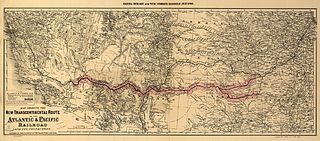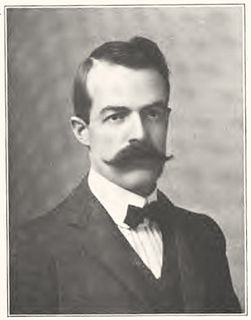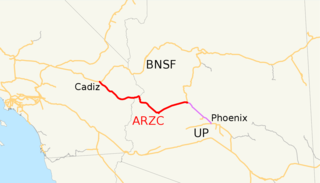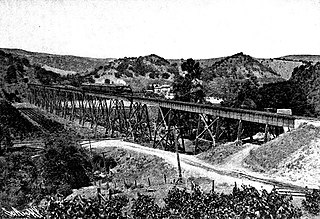Related Research Articles

The Atchison, Topeka and Santa Fe Railway, often referred to as the Santa Fe or AT&SF, was one of the larger railroads in the United States. The railroad was chartered in February, 1859 to serve the cities of Atchison, Kansas, Topeka, Kansas and Santa Fe, New Mexico. The railroad reached the Kansas–Colorado border in 1873 and Pueblo, Colorado in 1876. To create a demand for its services, the railroad set-up real estate offices and sold farmland from the land grants that it was awarded by Congress.

The Navajo was one of the named passenger trains of the Atchison, Topeka and Santa Fe Railway. The all-coach train began daily service between Chicago-Los Angeles-San Francisco as Train No. 9 (eastbound) and Train No. 2 (westbound) on October 1, 1915, as a replacement for the railroad's Tourist Flyer. In 1936, the westbound train was renumbered from Train No. 2 to Train No. 10. The Navajo was discontinued on January 14, 1940.

The Grand Canyon Limited was one of the named passenger trains of the Atchison, Topeka and Santa Fe Railway. It was train Nos. 23 & 24 between Chicago, Illinois, and Los Angeles, California.

Edward Payson Ripley, sometimes referred to as Edward P. Ripley or E. P. Ripley, was the fourteenth president of the Atchison, Topeka and Santa Fe Railway.

The Santa Fe Refrigerator Despatch was a railroad refrigerator car line established as a subsidiary of the Atchison, Topeka and Santa Fe Railway in 1884 to carry perishable commodities. Though the line started out with a mere 25 ventilated fruit cars and 8 ice-cooled refrigerator cars, by 1910 its roster had swollen to 6,055 total units.

The Atlantic and Pacific Railroad was a U.S. railroad that owned or operated two disjointed segments, one connecting St. Louis, Missouri with Tulsa, Oklahoma, and the other connecting Albuquerque, New Mexico with Southern California. It was incorporated by the U.S. Congress in 1866 as a transcontinental railroad connecting Springfield, Missouri and Van Buren, Arkansas with California. The central portion was never constructed, and the two halves later became parts of the St. Louis-San Francisco Railway and Atchison, Topeka and Santa Fe Railway systems, now both merged into the BNSF Railway.

The Santa Fe, Prescott and Phoenix Railway (SFP&P) was a common carrier railroad that later became an operating subsidiary of the Atchison, Topeka and Santa Fe Railway in Arizona. At Ash Fork, Arizona, the SFP&P connected with Santa Fe's operating subsidiary, the Atlantic & Pacific Railroad mainline, that ran from California to Chicago. The SFP&P's 195-mile (314 km) line extended the Santa Fe Railway south into Phoenix. The SFP&P extended another 100 miles (160 km) to the east from Phoenix to Florence and Winkelman via the Phoenix and Eastern Railroad. The SFP&P also served several mines in the Prescott area through its various subsidiary railroads.

The Texas Chief was a passenger train operated by the Atchison, Topeka and Santa Fe Railway between Chicago, Illinois, and Galveston, Texas. It was the first Santa Fe "Chief" outside the Chicago–Los Angeles routes. The Santa Fe conveyed the Texas Chief to Amtrak in 1971, which renamed it the Lone Star in 1974. The train was taken off in 1979.

Paul Pardee Hastings was a prominent executive of the Atchison, Topeka, and Santa Fe Railroad.

The Southern Transcon is a main line of BNSF Railway comprising 11 subdivisions between Southern California and Chicago, Illinois. Completed in its current alignment in 1908 by the Atchison, Topeka and Santa Fe Railway, when it opened the Belen Cutoff in New Mexico and bypassed the steep grades of Raton Pass, it now serves as a mostly double-tracked intermodal corridor.

The Arizona and California Railroad is a class III short line railroad that was a subdivision of the Atchison, Topeka and Santa Fe Railway (ATSF). The ARZC began operations on May 9, 1991, when David Parkinson of the ParkSierra RailGroup purchased the line from the Santa Fe Railway. ParkSierra Railgroup was purchased in January 2002 by shortline railroad holding company RailAmerica. The Genesee & Wyoming shortline railroad holding company purchased RailAmerica in December 2012. ARZC's main commodities are petroleum gas, steel, and lumber; the railroad hauls around 12,000 carloads per year.

Gulf, Colorado and Santa Fe Railroad Passenger Station is located on 1501 Jones Street in Fort Worth, Texas. The depot was built by the Gulf, Colorado and Santa Fe Railroad in 1900 and renovated in 1938. It was originally called the Fort Worth Union Depot. Other tenant railroads at the station were the Chicago, Rock Island and Gulf Railway, the St. Louis–San Francisco Railway ('Frisco') and the Southern Pacific Railroad.

The Valley Division of the Atchison, Topeka and Santa Fe Railway ran from San Francisco to Barstow in California. It is now part of the BNSF Railway's Stockton Subdivision and Bakersfield Subdivision.

The Muir Trestle, or Alhambra Trestle, is a railway trestle bridge in Martinez, California located within the John Muir National Historic Site. It is owned and operated by BNSF Railway and carries their Stockton Subdivision.
References
- ↑ Frailey, Fred W.; Bryant Jr., Keith L. (2020). History of the Atchison, Topeka and Santa Fe Railway. U of Nebraska Press. p. 162. ISBN 9781496222718.
- ↑ Glischinski, Steve (1997). Santa Fe Railway. Voyageur Press. p. 23. ISBN 9780760303801.
- ↑ Bennett, Herbert I. (July 15, 1905). "Extending the Santa Fe Railroad into San Francisco". Scientific American Supplement. Vol. 60 no. 1541.
- ↑ By The Way (PDF). Atchison, Topeka and Santa Fe Railway. May 1928. p. 67.
- ↑ Dur-Ite Co. v. Industrial Com, 394Ill. (September 18, 1946).
- ↑ "Franklin Tunnel Still Ablaze". San Francisco Call. January 29, 1907. p. 4.
